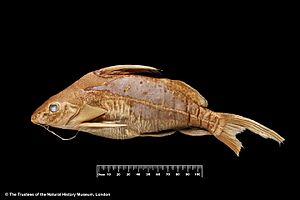Synodontis obesus facts for kids
Quick facts for kids Synodontis obesus |
|
|---|---|
 |
|
| Conservation status | |
| Scientific classification | |
| Genus: |
Synodontis
|
| Species: |
obesus
|
Synodontis obesus, also called the Coas synodontis, is a type of upside-down catfish. It lives in the rivers and coastal areas of countries like Cameroon, Ghana, Nigeria, and Togo in West Africa. A scientist named George Albert Boulenger first described this fish in 1898. Its name obesus comes from a Latin word meaning "fat," which describes its body shape.
Contents
What Does the Coas Synodontis Look Like?
Like other Synodontis fish, the Coas synodontis has a strong, bony head. This head bone goes all the way back to its first back fin spine. On its head, there is a special bony bump called a humeral process. The shape of this bump helps scientists tell different Synodontis species apart. For the Coas synodontis, this bump is longer than it is wide. It feels rough and might have a small ridge on its lower edge.
Fish Whiskers: Barbels
This fish has three pairs of barbels, which are like whiskers. One pair is on its upper jaw. Two more pairs are on its lower jaw. The upper jaw barbels are long and straight. They have a wide base and can be about one to one and a third times the length of the fish's head. The outer pair of lower jaw barbels is twice as long as the inner pair. Both lower jaw pairs have small, simple branches.
Fins and Spines
The front edges of the dorsal (back) fin and pectoral (side) fins are hard spines. The dorsal fin spine of the Coas synodontis is about two-thirds the length of its head. It is slightly curved and smooth on the front. The back of this spine has small teeth, like a saw. The rest of the dorsal fin has seven soft, branching rays. The pectoral fin spine is about as long as the dorsal spine. It has small teeth on both sides.
The adipose fin is a small, fleshy fin near the tail. It is three to four times longer than it is deep. The anal fin, located on the underside, has four unbranched rays and eight or nine branched rays. The tail fin is deeply forked, like a "V" shape. The upper part of the tail is longer and ends in a thin tip.
Teeth and Mouth
All Synodontis fish have a special toothpad on their upper jaw. This pad has several rows of short, chisel-shaped teeth. In the Coas synodontis, this toothpad is short and wide. On its lower jaw, the teeth are attached to flexible stalks. These teeth are shaped like an "S" or a hook. The number of teeth on the lower jaw helps identify the species. The Coas synodontis has about 18 to 28 teeth on its lower jaw.
Color and Size
The main color of the Coas synodontis is brown. It has darker brown spots or dots all over its body. These spots are easier to see on younger fish. Young fish also have whitish fins with round black spots. This fish can grow up to about 25.8 centimeters (about 10 inches) long. Female Synodontis fish are usually a bit larger than males of the same age.
Coas Synodontis Habitat and Behavior
Where They Live
In the wild, the Coas synodontis lives in the coastal rivers and streams of the Bay of Guinea. This area stretches from Ghana to Gabon in West Africa.
Special Abilities
This fish has a special electric organ. It can make a weak electric current. This helps it find its way around and protect itself. The Coas synodontis can also breathe air. This is very helpful because it allows the fish to live in water that does not have much oxygen.
In Aquariums
People sometimes keep the Coas synodontis as a pet in aquariums. It is a popular fish for fish tanks.
Reproduction and Diet
Scientists do not know much about how most Synodontis species reproduce. We know that females can carry many eggs. They likely lay their eggs during the rainy season, which is usually from July to October. During this time, pairs of fish might swim together to lay eggs.
Synodontis fish are omnivores. This means they eat both plants and animals. They enjoy eating insect larvae, algae, snails, clams, sponges, and small crustaceans. They also eat the eggs of other fish. Young Coas synodontis fish grow quickly in their first year. After that, their growth slows down as they get older.


